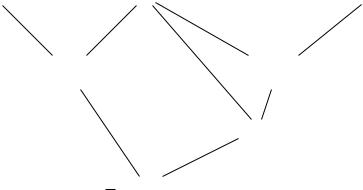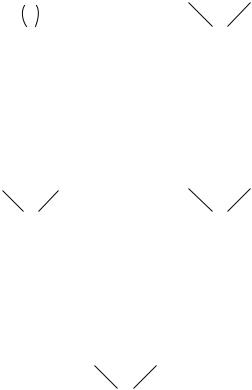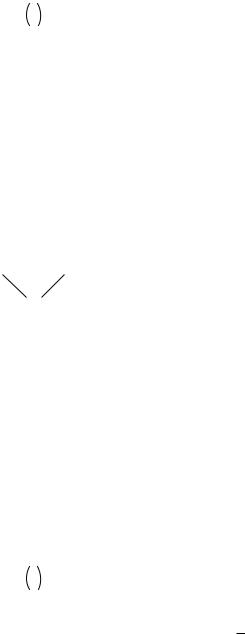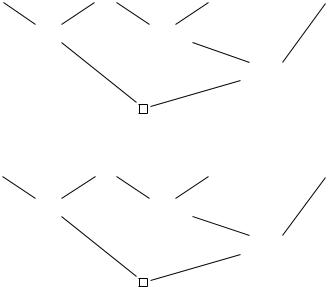

398 |
8/Resolution In First-Order Logic |
We will often use a simplified form of the above definition by dropping (ρ, ρ ) and σ from the interior nodes, and consider that nodes are labeled with clauses. This has the e ect that it is not always obvious how a resolvent is obtained.
EXAMPLE 8.5.2
Consider the following clauses:
C1 = {¬P (z1, a), ¬P (z1, x), ¬P (x, z1)},
C2 = {P (z2, f (z2)), P (z2, a)} and
C3 = {P (f (z3), z3), P (z3, a)}.
The following is a resolution refutation:
C2 |
C1 |
C3 |
({P (a, f (a))}, (Id, Id), |
({P (f (a), a)}, (Id, Id), |
(a/z1, a/z2, a/x)) |
(a/z1, a/x, a/z3)) |
|
({¬P (a, f (a))}, (Id, Id), (f (a)/z1, a/x)) |
( , (Id, Id), Id)
, (Id, Id), Id)
8.5.2 Soundness of the Resolution Method
In order to prove the soundness of the resolution method, we prove the following lemma, analogous to lemma 4.3.1.
Lemma 8.5.1 Given two clauses A and B, let C = σ(ρ(A − A ) ρ (B − B )) be any resolvent of A and B, for some subset A A of literals of A, subset B B of literals of B, separating pair of substitutions (ρ, ρ ), with ρ = (z1/x1, ..., zm/xm), ρ = (zm+1/y1, ..., zm+n/yn) and most general unifier
σ = (t1/u1, ..., tk/uk), where {u1, ..., uk} is a subset of {z1, ..., zm+n}. Also, let {v1, ..., vp} = F V (C). Then,
|= ( x1... xmA y1... ynB) v1... vpC.
Proof : We show that we can constuct a G-proof for
( x1... xmA y1... ynB) → v1... vpC.

8.5 The Resolution Method for First-Order Logic |
399 |
Note that {z1, ..., zm+n} − {u1, ..., uk} is a subset of {v1, ..., vp}. First, we perform p : right steps using p entirely new variables w1,...,wp. Let
σ = σ ◦ (w1/v1, ..., wp/vp) = (t1/z1, ..., tm+n/zm+n),
be the substitution obtained by composing σ and the substitution replacing each occurrence of the variable vi by the variable wi. Then, note that the support of σ is disjoint from the set {w1, ..., wp}, which means that for every
tree t,
σ (t) = t[t1/z1]...[tm+n/zm+n]
(the order being irrelevant). At this point, we have the sequent
( x1... xmA y1... ynB) → σ (ρ(A − A )), σ (ρ (B − B )).
Then apply the : lef t rule, obtaining
x1... xmA, y1... ynB → σ (ρ(A − A )), σ (ρ (B − B )).
At this point, we apply m+n : lef t rules as follows: If ρ(xi) is some variable uj , do the substitution tj /xi, else ρ(xi) is some variable vj not in {u1, .., uk}, do the substitution wj /vj .
If ρ (yi) is some variable uj , do the substitution tj /yi, else ρ (yj ) is some variable vj not in {u1, ..., uk}, do the substitution wj /vj .
It is easy to verify that at the end of these steps, we have the sequent
(σ (ρ(A − A )), Q), (σ (ρ (B − B )), Q) → σ (ρ(A − A )), σ (ρ (B − B ))
where Q = σ (ρ(A )) and Q = σ (ρ (B )) are conjugate literals, because σ is a most general unifier of the set |ρ(A ) ρ (B )|.
Hence, we have a quantifier-free sequent of the form
(A1 Q), (A2 ¬Q) → A1, A2,
and we conclude that this sequent is valid using the proof of lemma 4.3.1. 
As a consequence, we obtain the soundness of the resolution method.
Lemma 8.5.2 (Soundness of resolution without equality) If a set of clauses has a resolution refutation DAG, then S is unsatisfiable.
Proof : The proof is identical to the proof of lemma 4.3.2, but using lemma 8.5.1, as opposed to lemma 4.3.1. 

400 |
8/Resolution In First-Order Logic |
8.5.3 Completeness of the Resolution Method
In order to prove the completeness of the resolution method for first-order languages without equality, we shall prove the following lifting lemma.
Lemma 8.5.3 (Lifting lemma) Let A and B be two clauses, σ1 and σ2 two substitutions such that σ1(A) and σ2(B) are ground, and assume that D is a resolvent of the ground clauses σ1(A) and σ2(B). Then, there is a resolvent C of A and B and a substitution θ such that D = θ(C).
Proof : First, let (ρ, ρ ) be a separating pair of substitutions for A and B. Since ρ and ρ are bijections they have inverses ρ−1 and ρ −1. Let σ be the substitution formed by the union of ρ−1 ◦ σ1 and ρ −1 ◦ σ2, which is well defined, since the supports of ρ−1 and ρ −1 are disjoint. It is clear that
σ(ρ(A)) = σ1(A) and σ(ρ (B)) = σ2(B).
Hence, we can work with ρ(A) and ρ (B), whose sets of variables are disjoint. If D is a resolvent of the clauses σ1(A) and σ2(B), there is a ground literal Q such that σ(ρ(A)) contains Q and σ(ρ (B)) contains its conjugate. Assume that Q is positive, the case in which Q is negative being similar. Then, there must exist subsets A = {A1, ..., Am} of A and B = {¬B1, ..., ¬Bn} of B, such that
σ(ρ(A1)) = ... = σ(ρ(Am)) = σ(ρ (B1)) = ..., σ(ρ (Bn)) = Q,
and σ is a unifier of ρ(A ) ρ (B ). By theorem 8.4.1, there is a most general unifier λ and a substitution θ such that
σ = λ ◦ θ.
Let C be the resolvent
C = λ(ρ(A − A ) ρ (B − B )).
Clearly,
D= (σ(ρ(A)) − {Q}) (σ(ρ (B)) − {¬Q})
=(σ(ρ(A − A )) σ(ρ (B − B )))
=θ(λ(ρ(A − A ) ρ (B − B ))) = θ(C).
Using the above lemma, we can now prove the following lemma which shows that resolution DAGs of ground instances of clauses can be lifted to resolution DAGs using the original clauses.
Lemma 8.5.4 (Lifting lemma for resolution refutations) Let S be a finite set of clauses, and Sg be a set of ground instances of S, so that every clause in


402 |
8/Resolution In First-Order Logic |
where A and B are distinct, or of the form
(ii)(b)
DAG Hg
G1
A = B
D
if A = B .
(a) In the first case, by the induction hypothesis, there are DAGs H1 and H2 and homomorphisms F1 : H1 → G1 and F2 : H2 → G2, where H1 is rooted with some formula A and H2 is rooted with some formula B, and for some ground substitutions θ1 and θ2, we have, A = θ1(A) and B = θ2(B). By lemma 8.5.3, there is a resolvent C of A and B and a substitution θ such that θ(C) = D. We can construct H as the DAG obtained by making C as the root, and even if A = B, by creating two distinct nodes 1 and 2, with 1 labeled A and 2 labeled B:
DAG H
H1 H2
AB
C
The homomorphism F : H → Hg is defined such that F (e) = e, F (1) = 1, F (2) = 2, and it behaves like F1 on H1 and like F2 on H2. The root clause
Cis mapped to θ(C) = D.
(b)In the second case, by the induction hypothesis, there is a DAG H1
rooted with some formula A and a homomorphism F1 : H1 → G1, and for some ground substitution θ1, we have A = θ1(A). By lemma 8.5.3, there is a resolvent C of A with itself, and a substitution θ such that θ(C) = D. It is clear that we can form H so that C is a root node with two edges connected to A, and F is the homomorphism such that F (e) = e, F (1) = 1, and F behaves like F1 on H1.
DAG H
H1
A
C
The clause C is mapped onto D = θ(C). This concludes the proof. 

8.5 The Resolution Method for First-Order Logic |
403 |
EXAMPLE 8.5.3
The following shows a lifting of the ground resolution of example 8.3.1 for the clauses:
C1 = {¬P (z1, a), ¬P (z1, x), ¬P (x, z1)}
C2 = {P (z2, f (z2)), P (z2, a)}
C3 = {P (f (z3), z3), P (z3, a)}.
Recall that the ground instances are
G1 = {¬P (a, a)}
G2 = {P (a, f (a)), P (a, a)}
G3 = {P (f (a), a), P (a, a)}
G4 = {¬P (f (a), a), ¬P (a, f (a))},
and the substitutions are
|
σ1 = (a/z2) |
|
|
|
σ2 = (a/z1, a/x) |
|
|
|
σ3 |
= (a/z3) |
|
|
σ4 |
= (f (a)/z1, a/x). |
|
|
Ground resolution-refutation Hg |
|
|
|
for the set of ground clauses G1, G2, G3, G4 |
|
|
G2 |
G1 |
G3 |
G4 |
|
{P (a, f (a))} |
{P (f (a), a)} |
|
|
|
{¬P (a, f (a))} |
|
Lifting H of the above resolution refutation for the clauses C1, C2, C3
C2 |
C1 |
C3 |
C1 |
|
{P (a, f (a))} |
{P (f (a), a)} |
|
|
|
|
{¬P (a, f (a))} |
The homomorphism is the identity on the nodes, and the substitutions are, (a/z2) for node 11 labeled C2, (a/z1, a/x) for node 12 labeled C1,

404 |
8/Resolution In First-Order Logic |
(a/z3) for node 212 labeled C3, and (f (a)/z1, a/x) for node 22 labeled
C1.
Note that this DAG is not as concise as the DAG of example 8.5.1. This is because is has been designed so that there is a homomorphism from H to Hg .
As a consequence of the lifting theorem, we obtain the completeness of resolution.
Theorem 8.5.1 (Completeness of resolution, without equality) If a finite set S of clauses is unsatisfiable, then there is a resolution refutation for S.
Proof : By the Skolem-Herbrand-G¨odel theorem (theorem 7.6.1, or its corollary), S is unsatisfiable i a conjunction Sg of ground substitution instances of clauses in S is unsatisfiable. By the completeness of ground resolution (lemma 8.3.1), there is a ground resolution refutation Hg for Sg . By lemma 8.5.4, this resolution refutation can be lifted to a resolution refutation H for S. This concludes the proof. 
Actually, we can also prove the following type of Herbrand theorem for the resolution method, using the constructive nature of lemma 7.6.2.
Theorem 8.5.2 (A Herbrand-like theorem for resolution) Consider a firstorder language without equality. Given any prenex sentence A whose matrix is in CNF, if A → is LK-provable, then a resolution refutation of the clause form of A can be obtained constructively.
Proof : By lemma 7.6.2, a compound instance C of the Skolem form B of A can be obtained constructively. Observe that the Skolem form B of A is in fact a clause form of A, since A is in CNF. But C is in fact a conjunction of ground instances of the clauses in the clause form of A. Since ¬C is provable, the search procedure will give a proof that can be converted to a GCN F - proof. Since theorem 4.3.1 is constructive, we obtain a ground resolution refutation Hg . By the lifting lemma 8.5.4, a resolution refutation H can be constructively obtained for Sg . Hence, we have shown that a resolution refutation for the clause form of A can be constructively obtained from an LK-proof of A → . 
It is likely that theorem 8.5.2 has a converse, but we do not have a proof of such a result. A simpler result is to prove the converse of lemma 8.5.4, the lifting theorem. This would provide another proof of the soundness of resolution. It is indeed possible to show that given any resolution refutation H of a set S of clauses, a resolution refutation Hg for a certain set Sg of ground instances of S can be constructed. However, the homomorphism property does not hold directly, and one has to exercise care in the construction. The interested reader should consult the problems.
It should be noted that a Herbrand-like theorem for the resolution method and a certain Hilbert system has been proved by Joyner in his Ph.D
PROBLEMS |
405 |
thesis (Joyner, 1974). However, these considerations are somewhat beyond the scope of this text, and we will not pursue this matter any further.
PROBLEMS
8.5.1. Give separating pairs of substitutions for the following clauses:
{P (x, y, f (z))}, {P (y, z, f (z))}
{P (x, y), P (y, z)}, {Q(y, z), P (z, f (y))} {P (x, g(x))}, {P (x, g(x))}
8.5.2. Find all resolvents of the following pairs of clauses:
{P (x, y), P (y, z)}, {¬P (u, f (u))}
{P (x, x), ¬R(x, f (x))}, {R(x, y), Q(y, z)}
{P (x, y), ¬P (x, x), Q(x, f (x), z)}, {¬Q(f (x), x, z), P (x, z)} {P (x, f (x), z), P (u, w, w)}, {¬P (x, y, z), ¬P (z, z, z)}
8.5.3.Establish the unsatisfiability of each of the following formulae using the resolution method.
( x yP (x, y) x y¬P (x, y))
( x y z(L(x, y) L(y, z) Q(y) R(z) (P (z) ≡ R(x)))
x y z((L(x, y) L(y, z)) L(x, z)) x y¬(P (y) L(x, y)))
8.5.4.Consider the following formulae asserting that a binary relation is symmetric, transitive, and total:
S1 : x y(P (x, y) P (y, x))
S2 : x y z((P (x, y) P (y, z)) P (x, z))
S3 : x yP (x, y)
Prove by resolution that
S1 S2 S3 xP (x, x).
In other words, if P is symmetric, transitive and total, then P is reflexive.
8.5.5. Complete the details of the proof of lemma 8.5.1.

406 |
8/Resolution In First-Order Logic |
8.5.6. (a) Prove that given a resolution refutation H of a set S of clauses, a resolution refutation Hg for a certain set Sg of ground instances of S can be constructed.
Apply the above construction to the following refutation:
{¬P (a), Q(a)} |
{P (x)} |
{¬P (f (a)), ¬Q(a)} |
{Q(a)} |
|
{¬Q(a)} |
(b) Using (a), give another proof of the soundness of the resolution method.
8.5.7. As in the propositional case, another way of presenting the resolution method is as follows. Given a (finite) set S of clauses, let
R(S) = S {C | C is a resolvent of two clauses in S}.
Also, let
R0(S) = S,
Rn+1(S) = R(Rn(S)), (n ≥ 0), and let
R (S) = Rn(S).
n≥0
(a)Prove that S is unsatisfiable if and only if R (S) is unsatisfiable.
(b)Prove that if S is finite, there is some n ≥ 0 such that
R (S) = Rn(S).
(c)Prove that there is a resolution refutation for S if and only if the empty clause 
 is in R (S).
is in R (S).
(d)Prove that S is unsatisfiable if and only if 
 belongs to R (S).
belongs to R (S).
8.5.8.Prove that the resolution method is still complete if the resolution rule is restricted to clauses that are not tautologies (that is, clauses not containing both A and ¬A for some atomic formula A).
8.5.9. We say that a clause C1 subsumes a clause C2 if there is a substitution σ such that σ(C1) is a subset of C2. In the version of the resolution method described in problem 8.5.7, let
R1(S) = R(S) − {C | C is subsumed by some clause in R(S)}. Let R10 = S,
R1n+1(S) = R1(R1n(S)) and
R1 (S) = R1n(S).
n≥0

8.6 A Glimpse at Paramodulation |
407 |
Prove that S is unsatisfiable if and only if  belongs to R1 (S).
belongs to R1 (S).
8.5.10.The resolution method described in problem 8.5.7 can be modified by introducing the concept of factoring. Given a clause C, if C is any subset of C and C is unifiable, the clause σ(C) where σ is a most general unifier of C is a factor of C. The factoring rule is the rule that allows any factor of a clause to be added to R(S). Consider
the simplification of the resolution rule in which a resolvent of two clauses A and B is obtained by resolving sets A and B consisting of a single literal. This restricted version of the resolution rule is sometimes called binary resolution.
(a)Show that binary resolution together with the factoring rule is complete.
(b)Show that the factoring rule can be restricted to sets C consisting of a pair of literals.
(c)Show that binary resolution alone is not complete.
8.5.11.Prove that the resolution method is also complete for infinite sets of clauses.
8.5.12.Write a computer program implementing the resolution method.
8.6 A Glimpse at Paramodulation
As we have noted earlier, equality causes complications in automatic theorem proving. Several methods for handling equality with the resolution method have been proposed, including the paramodulation method (Robinson and Wos, 1969), and the E-resolution method (Morris, 1969; Anderson, 1970). Due to the lack of space, we will only define the paramodulation rule, but we will not give a full treatment of this method.
In order to define the paramodulation rule, it is convenient to assume that the factoring rule is added to the resolution method. Given a clause A, if A is any subset of A and A is unifiable, the clause σ(A) where σ is a most general unifier of A is a factor of A. Using the factoring rule, it is easy to see that the resolution rule can be simplified, so that a resolvent of two clauses A and B is obtained by resolving sets A and B consisting of a single literal. This restricted version of the resolution rule is sometimes called binary resolution (this is a poor choice of terminology since both this restricted rule and the general resolution rule take two clauses as arguments, but yet, it is used in the literature!). It can be shown that binary resolution alone is not complete, but it is easy to show that it is complete together with the factoring rule (see problem 8.5.10).
.
The paramodulation rule is a rule that treats an equation s = t as a (two way) rewrite rule, and allows the replacement of a subterm r unifiable with
